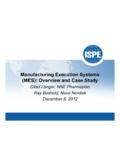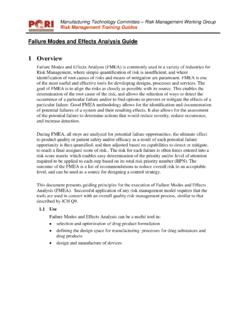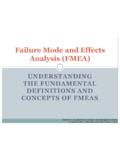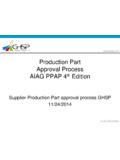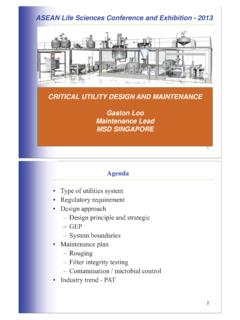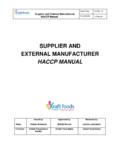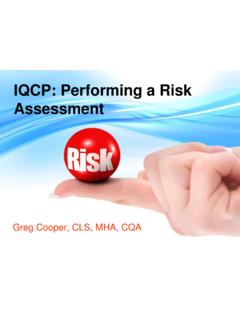Transcription of Quality Risk Management (QRM) - ispe-casa.org
1 Quality Risk Management (QRM). Steve Wisniewski Mike Porter AGENDA. Introduction to QRM and overview of ASTM E2500 . Steve Risk Management Mike Risk Tool Selection Steve Risk Assessment Mike Workshop Risk Perception Required to be done by . Regulatory agency Upcoming inspection Corporate policy OR. Useful tool that . Provides common understanding of process Helps qualify equipment or validate process Identifies gaps in process understanding What is Risk? ICH Q9 and ISO/IEC Guide 51. Definition: The combination of the probability of occurrence of harm and the severity of that harm Note: detection is not specifically discussed in the definition Risk Management is Universal All industries use risk assessment in an attempt to answer the following questions: Military Aerospace What can go wrong?
2 How often does it happen? How bad are the consequences? Is the risk acceptable? Commercial Aviation Petrochemical Rail Nuclear Risk Management in Human Health Medical Device Industry Pharma/Biotech Industries Utilized Risk Assessments for a Relatively new to Risk long time Assessment/ Management Driven from the automotive Driven with a focus on industry optimizing design and Utilize primarily a Failure Mode validation Effect Analysis (FMEA) approach Focused on equipment and Product focused process Key Terminology Harm: Damage to health, including the damage that can occur from loss of product Quality or availability Hazard: The potential source of harm (ISO/IEC Guide 51). Risk: The combination of the probability of occurrence of harm and the severity of that harm (ISO/IEC Guide 51).
3 Control: The approach defined to maintain the output of a specific process within a desired range severity : A measure of the possible consequences of a hazard occurrence : The frequency with which an event happens Detectability: The ability to discover or determine the existence, presence, or fact of a hazard Risk Assessments Risk assessment is an attempt to answer the following questions: What can go wrong? Risk How bad are the consequences? severity How often does/will it happen? Probability of occurrence If it happened, how would we know? Likelihood of detection Is the risk acceptable? Risk Evaluation, Remediation Risk Management in Pharma/Biotech ASTM E2500-07. A consensus standard based on sound scientific, engineering and Quality principles that separates business risk from patient safety risk Focus on product and process design through detailed requirements and mitigating risks in the design phase Evolution Of Commissioning & Qualification FDA: FDA: Quality Pharmaceutical Systems FDA EU CGMPs For Guide to Annex Approach to The 21st ICH Q9 Pharmaceutical Process 15 ICH ISPE GPG.
4 Century cGMP. Validation Q10 ARM C&Q. Regulations 1987 2000 2002 2004 2006 2008 2010 2011. ss22222222222222222010201020102201120102 04321093248 0932148 093218420394820934802 93840293842010. ISPE ISPE 21st ASTM EU. ICH Q8 E2500- Annex FDA ISPE. C&Q Century Process Guide Baseline Qualification 07 20. Val. FSE /. 5 Guide White Paper Guidance ICH Q9. ASTM. Question . Why change our work cultures & regulatory framework to move from the traditional qualification approach to a value added model? Qualification A Broken Process IQ/OQ had become more intensive than PQ. Organizations refused to leverage commissioning Automated systems and the controlled equipment were qualified separately and inefficiently Deviations for trivial items diluted Q-unit attention Change-is-bad attitudes driven by cost/time What is a Science and Risk Based Approach (RBA)?
5 A paradigm shift in the global pharmaceutical industry Pharma and Regulatory Agencies applying an all-encompassing approach to qualification Using focused methodologies to assess the scope of qualification 13. What is a Science and Risk Based Approach (RBA)? The identification and control of risks to product Quality Formality and documentation commensurate with risk The use of (GEP) to verify installation and operation Verification that system performance meets product and process user requirements Think about it: If everything is critical, then nothing is. 14. 10 Principles for Risk-Based Qualification 1. Focus on that which affects product Quality 2. Process User Requirements key to acceptability (IQ/OQ subordinate to PQ). 3. Risk assessments and process knowledge used to identify critical elements 4.
6 Only critical features/functions to be qualified 5. All activities must contribute value ISPE White Paper Risk Based Qualification for the 21 st Century March 2005. 10 Principles for Risk-Based Qualification 6. Risk-based asset delivery not cookbook requirements 7. Value-added documents based on technical merit 8. Use of supplier documentation 9. Test planning (and one-time testing). 10. Foster innovation all change is not bad ISPE White Paper Risk Based Qualification for the 21 st Century March 2005. 16. Qualification - Traditional vs. RBA. Traditional Approach Risk-Based Approach (Product) User Requirements Process Requirements not Formally Documented Documented, Approved Protocols Developed from Risk Assessments Determine Templates Critical Aspects of Design IQ/OQ Protocols Engineering Testing Preapproved ( Commissioning ).
7 Commissioning not Verification Leveraged All Documents with Technical Engineering and Validation Merit Used as Evidence of Personnel Often Distinct Fitness for Use Emphasis on Documents Emphasis on Meeting Not System Performance Process Requirements ASTM Standard E 2500-07. ASTM Standard for Specification, Design & Verification of Pharmaceutical & Biopharmaceutical Manufacturing Systems & Equipment . The ASTM Standard provides a science and risk based approach to assure that GMP equipment &. systems are: Fit for use Perform satisfactorily May be used in the manufacturing, processing, packaging and holding of a drug ASTM Standard Summary Describes a risk and science-based approach to: Specification, design, and verification of manufacturing systems/equipment that have the potential to affect product Quality and patient safety A systematic, efficient, and effective way of ensuring that manufacturing systems and equipment are fit for intended use Provides manufacturing capability to support defined and controlled processes meeting defined Quality requirements ASTM Standard Scope Applicable to all elements of pharmaceutical and biopharmaceutical manufacturing systems.
8 Facility equipment, process equipment, supporting utilities Associated process control and automation systems, that have the potential to affect product Quality and public safety Applicable to new and existing manufacturing elements May be used for the implementation of changes to existing elements, and their continuous improvement during operation Bridge From Baseline Guide 5 to Risk-Based ASTM Verification You may Start here and want to get here . or just stop here or here . QRM - BG 5 Land C&Q. Verification The New' (old) Approach A systematic approach should be defined to verify that Manufacturing Elements, acting singly or in combination, are fit for intended use, have been properly installed, and operating correctly This verification approach should be defined and documented The extent of verification and the level of detail of documentation should be based on risk to product Quality and patient safety, complexity, and novelty of the manufacturing system Critical Aspects of Manufacturing Systems Critical aspects are typically.
9 Functions, features, abilities, and performance or Quality characteristics necessary to ensure consistent product Quality and patient safety Should be identified and documented based on scientific product and process understanding Verification activities should focus on these aspects of manufacturing systems and should be documented Know Your Critical P's & Q's (& A's). Critical Quality Attributes (CQA). Critical Process Parameters (CPP). Critical Aspects (CA). Critical Quality Attributes From ICH Q8: A physical, chemical, biological or microbiological property or characteristic that should be within an appropriate limit, range, or distribution to ensure the desired product Quality Essential to producing the desired outcome In life sciences risk approach, relating specifically to product Quality and/or patient safety requirements Product identity, potency, size/dissolution (easy to swallow/digest), clean/sterile, and so on Critical Process Parameters (CPP).
10 From ICH Q8: A process parameter whose variability has an impact on a critical Quality attribute and therefore should be monitored or controlled to ensure the process produces the desired Quality The control targets and ranges for critical attributes Control setpoints, alarm points, time, etc. Critical Aspects Operational Definition (manufacturing systems): Functions and/or features of a manufacturing system that control manufacturing processes product Quality or patient safety requirements ensuring a CQA is met System Design Example Process Step Potential CQA. Potential CPP. Designed System Potential Critical Aspects Distillation Impurity Solvent ratio, Reactor Temperature control, Profile Temperature, Flow load cell control, Final volume, IPC test (sample Solvent add rate, device).
